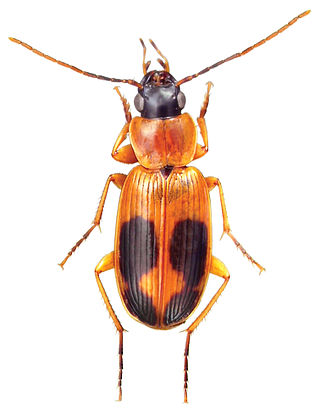
Leptopelis flavomaculatus is a species of frog in the family Arthroleptidae. It is found in the lowlands eastern and southern Africa, from Mozambique north of the Save River and Zimbabwe to Malawi, eastern Tanzania, and coastal Kenya. Its common names are yellow-spotted tree frog, brown-backed tree frog, brown forest treefrog, and Johnston's treefrog.

Crocidura grandiceps, commonly known as the large-headed forest shrew or the large-headed white-toothed shrew, is a species of mammal in the family Soricidae. It is found in Benin, Ivory Coast, Ghana, Guinea, Liberia, Nigeria, and Togo. Its natural habitat is subtropical or tropical moist lowland forests. It is threatened by habitat loss due to agriculture and aquaculture as well as logging and wood harvesting. To increase habitat protection for C. grandiceps, in-place land/water protection conservation actions are in place. The vernacular name large-headed shrew is sometimes applied to C. grandiceps but has also been used for the entire related genus Paracrocidura. The IUCN List categorizes C. grandiceps as least concern as of 2024.
Paracrocidura is a genus of shrews. They are mammals in the family Soricidae. The vernacular name large-headed shrews is sometimes collectively applied to the genus, but has also been applied to the species Crocidura grandiceps.

Brownea grandiceps is a species of tree in the family Fabaceae. Its common names include the rose of Venezuela and the scarlet flame bean. It originated in South America but is now widely grown as a decorative tree in tropical gardens.

Amphibamus is a genus of amphibamid temnospondyl amphibians from the Carboniferous of North America. This animal is considered to have been close to the ancestry of modern amphibians. Its length was about 20 centimetres (7.9 in).

Badister is a genus of ground beetle in the family Carabidae native to North Africa, the Near East, and the Holarctic, including Europe.
Badister ajax is a species of ground beetle that is in the genus Badister. Badister ajax was discovered by the scientist Britton in 1948 and is endemic to Yemen.

Badister elegans is a species of ground beetle in the family Carabidae. It is found in North America.
Badister notatus is a species of ground beetle in the family Carabidae. It is found in North America.
Badister flavipes is a species of ground beetle in the family Carabidae. It is found in the Caribbean Sea, Central America, North America, and South America.
Badister transversus is a species of ground beetle in the family Carabidae. It is found in North America.
Metisotoma grandiceps is a species of elongate-bodied springtail in the family Isotomidae. It is the only predatory springtail known so far.

Badister maculatus is a species of ground beetle in the family Carabidae. It is found in North America, mainly east of the Rocky Mountains.
Badister micans is a species of ground beetle in the family Carabidae. It is found in North America.
Badister reflexus is a species of ground beetle in the family Carabidae. It is found in North America.
Badister parviceps is a species of ground beetle in the family Carabidae, which lives in North America.

Badister neopulchellus is a species of ground beetle in the family Carabidae. It is found in North America.
Stenodactylus grandiceps, also known as the Jordan short-fingered gecko or stout gecko, is a species of lizard in the family Gekkonidae. The species is found in the Middle East.

Amphibamiformes is an unranked clade with Dissorophoidea created by Schoch (2018). It encompasses all of the taxa traditionally considered to be "amphibamids", branchiosaurids, and hypothetically lissamphibians under the traditional temnospondyl hypothesis of lissamphibian origins. These taxa are typically small-bodied dissorophoids and form the sister group to Olsoniformes, which comprises dissorophids and trematopids.

Protea grandiceps, commonly known as rooisuikerbos, suikerbos or red sugarbush, is a flowering shrub that belongs to the Protea genus and is native to south western parts of South Africa. The shrub was listed as a near threatened species in 2006 according to the South African National Biodiversity Institute.








